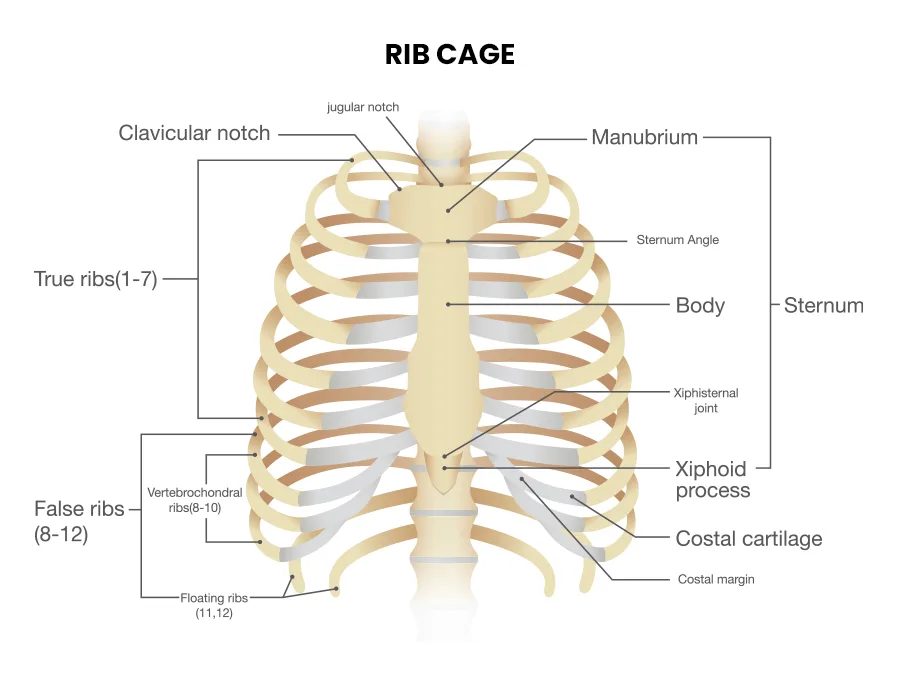
Ribs: The ribs are a group of bones that extend from the spinal column around the torso and connect to the sternum, or breast bone. They act as attachment points for a variety of breathing muscles and are vital in safeguarding the organs located within the thoracic cavity. There are a total of 24 ribs in the human body, with 12 on each side.
Ribs are long, curved bones that form the rib cage, which is part of the axial skeleton. In most tetrapods, including humans, ribs enclose the chest, allowing for the expansion of the lungs during breathing by enlarging the chest cavity. This function helps protect vital organs such as the lungs, heart, and other thoracic organs. In some animals, particularly snakes, ribs can provide support and protection for the entire body. The article below provides more information on ribs, including their classification and other functions in the human body.Pre Fertilisation: Structures and Events
What are Ribs?
The rib cage, which contains the human ribs, is part of the axial skeleton and is located in the center of the body. It protects vital organs like the heart and lungs. The rib cage is part of the thoracic cavity, also called the thoracic cage. This cavity contains a variety of organs critical to human survival, including those of the respiratory, cardiovascular, nervous, immune, and digestive systems, which require additional protection. The organs present in the ribs include:| Human Rib Cage | |
|---|---|
| System | Organs |
| Respiratory | Lungs, Bronchi, Trachea, Pleura |
| Cardiovascular | Heart, Major blood vessels, Pericardium |
| Nervous | Vagus nerve, Sympathetic chain, Recurrent laryngeal nerve, Phrenic nerve |
| Immune | Thymus |
| Digestive | Esophagus |
Ribs Anatomy (Structure)
In vertebrate anatomy, the rib cage is a bony structure made up of the ribs, their connections to the sternum (breastbone), and the vertebral column. It makes up the thorax, or chest, and protects the heart and lungs. The rib cage is made up of 24 ribs attached to the 12 thoracic vertebrae and the sternum. Each rib is joined to a thoracic vertebra and the sternum by joints and cartilage, allowing for slight movement while breathing and performing other tasks. Ribs are classified according to their connection to the sternum. True ribs articulate with the sternum, whereas false ribs do not. The eleventh and twelfth ribs, also known as floating ribs, are considered false ribs because they do not connect to the sternum. Ribs are anatomically made up of a head with two articular facets, a tubercle, a neck, a shaft, and a costal groove. The typical structure of a rib is divided into several components:- Head: This is the part of the rib that connects to the spine. It has two surfaces that articulate with the vertebra.
- Neck: The neck is a short, bony segment that links the head to the body of the rib.
- Body (shaft): The body is the main, flat, curved portion of the rib. It has a groove on its inner surface to protect blood vessels and nerves.
- Tubercle: A bony protrusion on the upper surface of the rib body that includes a facet that connects to a vertebra's transverse process .
- Angle: The angle is the sharp curve in the rib's body that provides additional strength and leverage to the muscles that attach to the ribs.

| Other NEET Biology Topics | ||
|---|---|---|
| Ribosomes | Pollination | Apomixis |
| Centrosome | Embryo | Tissues |
Types of Ribs
Ribs are classified into three categories based on their attachment to the breastbone:- True ribs (vertebrosternal ribs): These are the first seven pairs of ribs, attaching directly to the sternum with their own costal cartilages.
- False ribs (vertebrochondral ribs): The following three pairs of ribs (ribs 8, 9, and 10) are known as false ribs because they do not directly attach to the sternum. Instead, their costal cartilages are connected to the rib cartilage above.
- Floating ribs (vertebral ribs): The last two pairs of ribs (ribs 11 and 12) are termed floating ribs because their anterior ends are free and do not attach to the sternum or any other ribs. They are embedded in the muscles of the abdominal wall.
Ribs Functions
The ribs perform several vital functions in the body:- Protection: Ribs form a protective enclosure around essential organs such as the heart and lungs, safeguarding them from external harm.
- Respiration: The rib cage expands and contracts during breathing, aiding in lung expansion and air intake.
- Posture Support: Ribs offer structural support for the spine, aiding in maintaining an upright posture and balance.
- Muscle Attachment: Ribs act as points of attachment for muscles involved in breathing and movement of the trunk.
- Blood Cell Production: The ribs contain bone marrow, where red and white blood cells are generated.
- Thermal Regulation: The rib cage helps regulate body temperature by assisting in the expansion and contraction of the lungs, which can impact heat exchange during breathing.
Ribs in the Human Body
The rib cage, a bony structure in the chest, performs important functions in the human body. It is made up of 12 pairs of curved ribs that wrap around the chest to protect vital organs like the heart and lungs. These ribs are connected to the spine in the back and the breastbone (sternum) in the front, forming a protective cage around the organs. One of the primary functions of the rib cage is to aid in breathing. When a person inhales, the rib cage expands and the lungs fill with air. When you exhale, the rib cage contracts, which helps to push air out of your lungs. Additionally, the rib cage provides support and stability to the chest, enabling upright posture and freedom of movement. Furthermore, the rib cage serves as an attachment point for muscles. Various muscles, including those involved in breathing and movement of the arms and shoulders, attach to the ribs, enabling various activities. In summary, the rib cage is an essential part of the human body, providing protection, support, and stability, while also playing a crucial role in breathing and movement. Physics Wallah provides the online coaching for NEET class 11 in India. It provides high-quality instruction at an affordable price. The course is designed to make learning simple and effective, helping NEET exam candidates succeed. PW connects students with expert teachers who simplify complex concepts.| NEET Exam Important Links | |
|---|---|
| NEET Syllabus | NEET Biology Diagrams |
| NEET Biology MCQ | NEET Biology Chapter wise Weightage |
| NEET Biology Notes | NEET Previous Year Question papers |
Ribs FAQs
How many ribs do humans have?
Most people are born with 12 pairs of ribs, totaling 24, regardless of their sex. Exceptions to this include individuals born with specific genetic anomalies, leading to either supernumerary ribs (too many) or agenesis of ribs (too few).
What are the 3 types of ribs?
Ribs are classified into three groups based on their attachment to the sternum: true ribs, false ribs, and floating ribs.
What are the 12 ribs called?
Ribs 8-12 are classified as false ribs (vertebrochondral ribs). The costal cartilages of these ribs are not directly attached to the sternum.
What is the 13th rib in the human body?
Lumbar (or 13th) ribs are a rare anatomical variant, representing transitional vertebrae at the thoracolumbar junction. They have a prevalence of approximately 1% and appear as an additional rib originating from either T13 or L1, potentially being unilateral or bilateral.
Which rib is the smallest?
The shortest true rib is rib 1, and their length increases progressively to rib 7. Additionally, the radius of their curvature increases as they progress inferiorly.
Do men have 23 or 24 ribs?
The vast majority of individuals are born with 24 ribs, 12 on each side of the body. Despite a common misconception, men and women have the same number of ribs. However, some people are born with more or fewer than the typical 24 ribs.
Talk to a counsellorHave doubts? Our support team will be happy to assist you!

Check out these Related Articles
Free Learning Resources
PW Books
Notes (Class 10-12)
PW Study Materials
Notes (Class 6-9)
Ncert Solutions
Govt Exams
Class 6th to 12th Online Courses
Govt Job Exams Courses
UPSC Coaching
Defence Exam Coaching
Gate Exam Coaching
Other Exams
Know about Physics Wallah
Physics Wallah is an Indian edtech platform that provides accessible & comprehensive learning experiences to students from Class 6th to postgraduate level. We also provide extensive NCERT solutions, sample paper, NEET, JEE Mains, BITSAT previous year papers & more such resources to students. Physics Wallah also caters to over 3.5 million registered students and over 78 lakh+ Youtube subscribers with 4.8 rating on its app.
We Stand Out because
We provide students with intensive courses with India’s qualified & experienced faculties & mentors. PW strives to make the learning experience comprehensive and accessible for students of all sections of society. We believe in empowering every single student who couldn't dream of a good career in engineering and medical field earlier.
Our Key Focus Areas
Physics Wallah's main focus is to make the learning experience as economical as possible for all students. With our affordable courses like Lakshya, Udaan and Arjuna and many others, we have been able to provide a platform for lakhs of aspirants. From providing Chemistry, Maths, Physics formula to giving e-books of eminent authors like RD Sharma, RS Aggarwal and Lakhmir Singh, PW focuses on every single student's need for preparation.
What Makes Us Different
Physics Wallah strives to develop a comprehensive pedagogical structure for students, where they get a state-of-the-art learning experience with study material and resources. Apart from catering students preparing for JEE Mains and NEET, PW also provides study material for each state board like Uttar Pradesh, Bihar, and others
Copyright © 2025 Physicswallah Limited All rights reserved.
Get App









